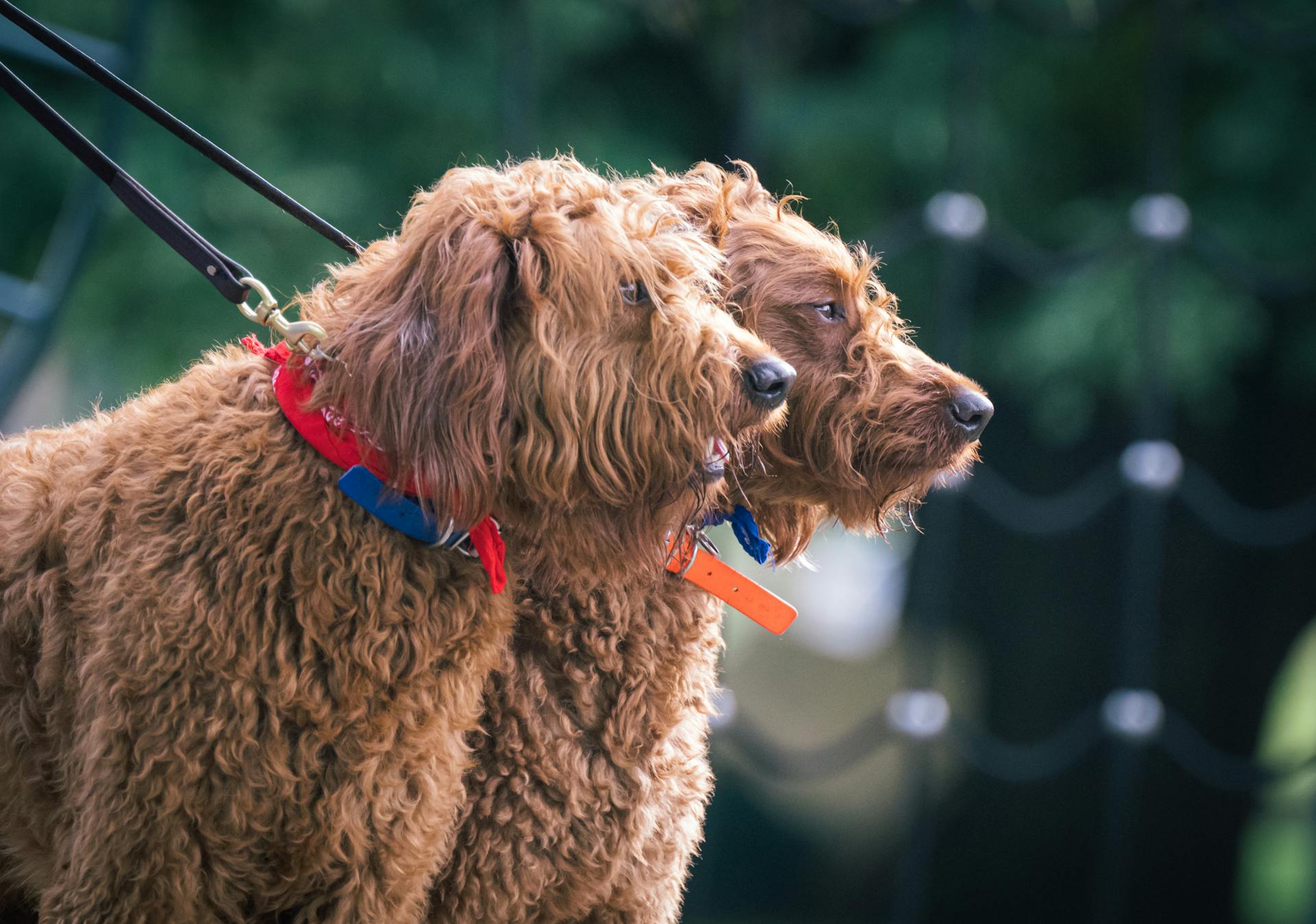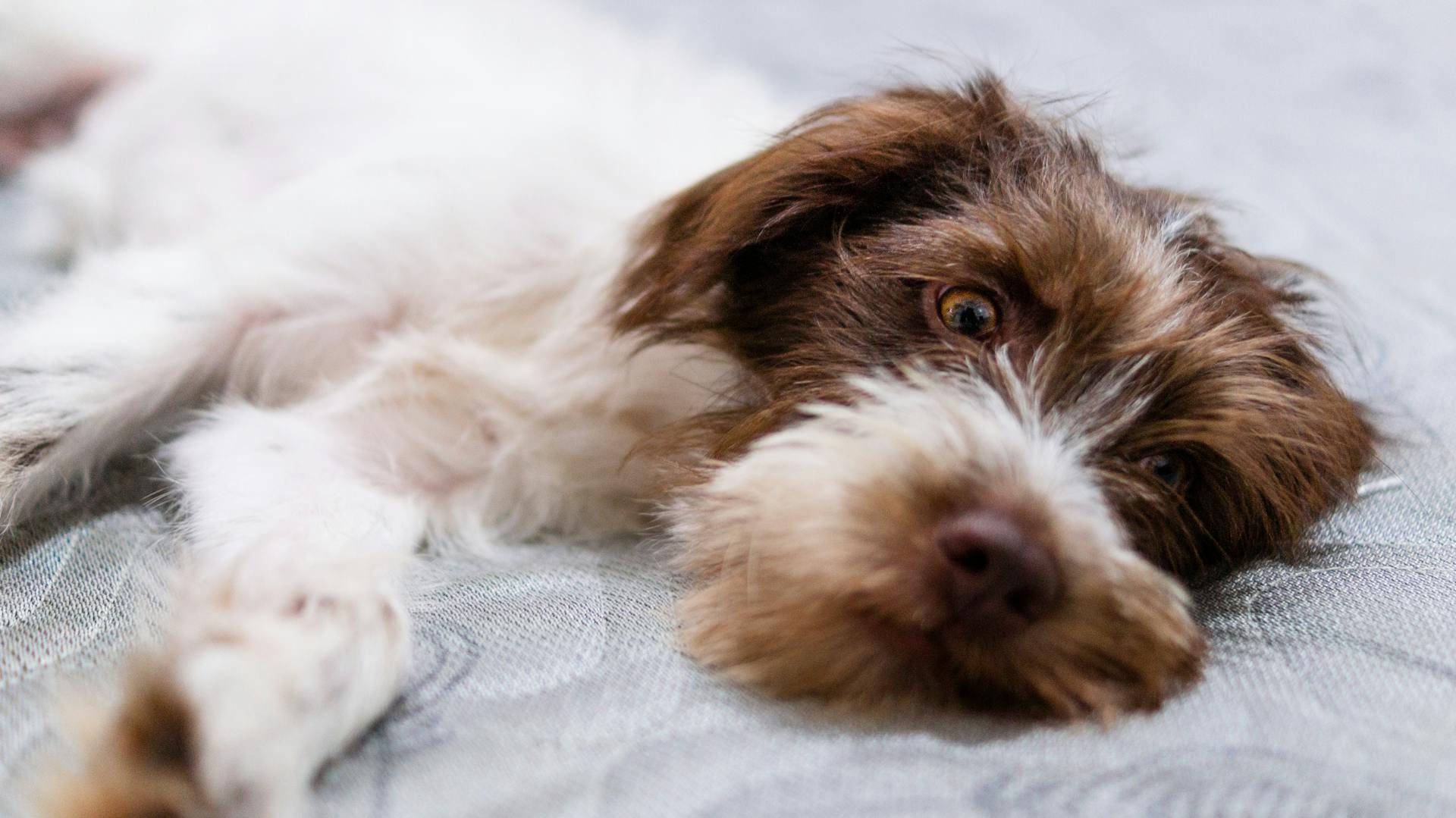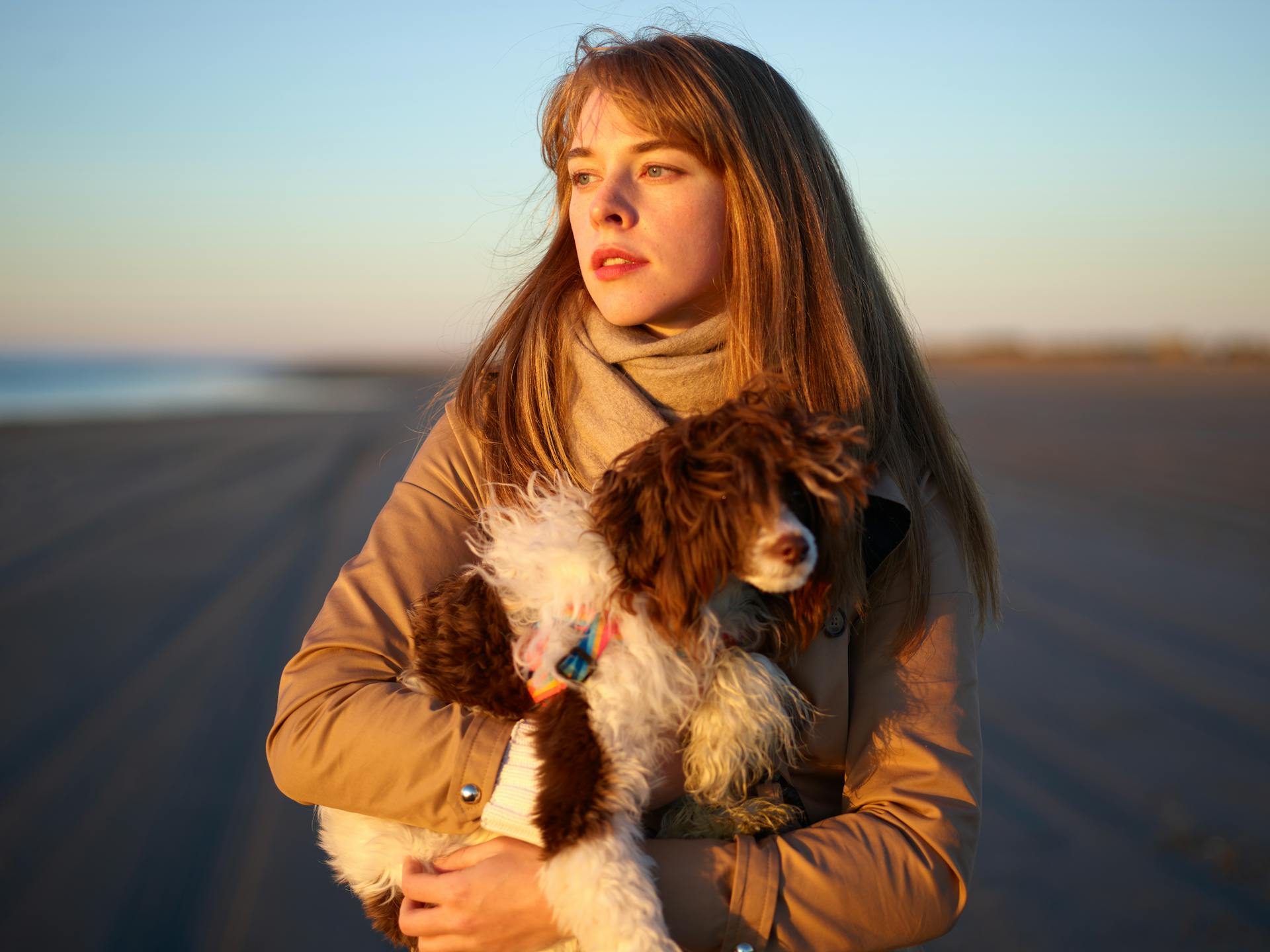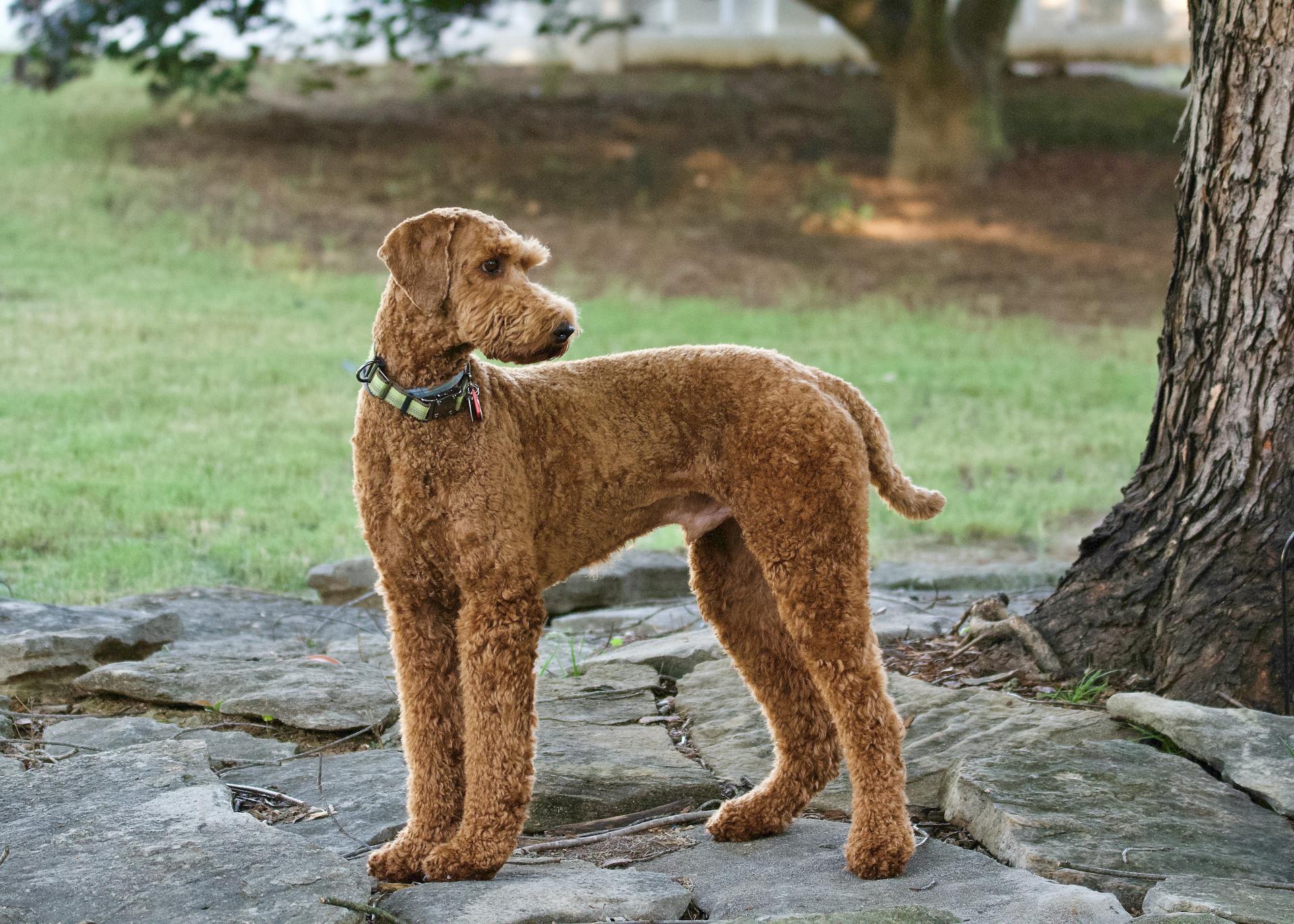
Labradoodles often inherit the outgoing and affectionate nature of their Labrador parent.
Their high energy levels and love for exercise are also common traits passed down from the Labrador side.
Labradoodles tend to be more eager to please and quick to learn, which is a characteristic often associated with Labradors.
Their strong desire to please their owners can sometimes make them more prone to obedience training, which is a skill Labradors are known for.
In terms of physical appearance, Labradoodles often inherit the Labrador's distinctive coat pattern, with a mix of black and tan colors.
Labradoodle Genetics
The genetics of a Labradoodle can be complex, but it's interesting to note that the bulk of the Australian Labradoodle genome contains poodles of all sizes, a dash of Lab, and a hint of American Cocker Spaniel.
Dr. Ostrander and colleagues analyzed the DNA of 21 pedigree Australian Labradoodles in the US, and found that the dominance of poodle genes in the mix reflects breeding programs that have reintroduced poodles to later generations of Labradoodles.
This is what you would expect if breeders were selecting for the coat gene, said Claire Wade, an animal genetics expert from the University of Sydney.
The F1b generation of Labradoodle, which is a cross between a first-generation Labradoodle and a purebred Labrador, has a predominance of poodle in the mix due to strong selection for the coat gene.
Breeders may decide to breed an F1b generation to try and secure more Labrador traits, while retaining some desirable Poodle traits.
Here are some possible outcomes of breeding an F1b generation:
- More social confidence around unfamiliar dogs
- A non-shedding coat
Labradoodle Basics
Labradoodles are a cross between a Labrador Retriever and a Poodle, but did you know that they often lean more towards their Labrador heritage? They tend to inherit the friendly and outgoing personality of their Labrador parent.
Labradoodles are a relatively new breed, first developed in the 1980s to create a low-shedding guide dog. This makes them a popular choice for people with allergies.
In terms of size, Labradoodles can range from 18 to 24 inches in height, with some larger than their Labrador parent. Their weight can also vary, but they typically weigh between 50 and 90 pounds.
Labradoodle Overview
Labradoodles are a medium to large breed with a long working history, which means they have lots of stamina and need lots of physical activity every day. This can include activities like hiking, swimming, and playing fetch in your yard.
They benefit from a mix of physical and mental stimulation, which makes them more restful company at the end of the day. Dog sports are a great option because they provide both physical exercise and mental engagement.
Some popular dog sports for Labradoodles include fly ball, dock diving, traditional agility, hooper agility, canine freestyle, and gundog training. These activities can be adapted to suit your dog's age and ability.
As a puppy, your Labradoodle needs to exercise gently and judiciously to avoid damaging their immature joints.
Labradoodle Labrador Mix
The Labradoodle Labrador mix is a fascinating topic. This mix is created by crossing a first-generation Labradoodle with a pedigree Labrador, resulting in an F1b generation.
The F1b generation is a specific type of mix, where the F stands for "filial", indicating the relationship between parents and offspring. The 1 represents how many generations removed a puppy is from its closest purebred parent, in this case, one generation apart.
The b stands for "back cross", indicating that a mixed-breed dog has been mated with a pedigree dog from one of its parents' breeds. This breeding method is used to try and secure more Labrador traits while retaining some desirable Poodle traits.
Labradors are known for their social confidence around unfamiliar dogs, which is a trait that may be passed down to the Labradoodle Labrador mix. Poodles, on the other hand, are famous for their non-shedding coat, which is another desirable trait that may be inherited by this mix.
While the outcome of this mix is not guaranteed, breeders may use this method to create a dog with the best of both worlds.
Are Labradoodles Uniform?
Labradoodles are not a uniform breed, as there are different types of poodle mixes. The American version of the Labradoodle is a one-generation breed, created by crossing a Poodle with a Labrador Retriever.
The Australian Labradoodle, on the other hand, has a more complex ancestry, with six different breeds in its origin. This includes the Poodle, Labrador Retriever, and several other breeds like the Curly Coat Retriever and English Cocker Spaniel.
Labradoodles can be categorized into different generations, such as F1 and F1b, which refers to the first cross between a Lab and a Poodle and the cross between an F1 Labradoodle and a Poodle, respectively.
The Australian Labradoodle breed is now in its 40th generation, indicating a long history of breeding and selection.
Labradoodle Care
Labradoodles require regular grooming to prevent matting and tangling of their fur, which can be a challenge for owners who are new to dog grooming.
They need to be brushed at least 2-3 times a week to prevent matting and tangling, and some owners prefer to brush their Labradoodles daily.
Labradoodles are generally healthy dogs, but they can be prone to certain health issues such as hip dysplasia and eye problems, which can be inherited from their Labrador Retriever parent.
Regular exercise and a balanced diet can help prevent these health issues and keep your Labradoodle happy and healthy.
Labradoodles are highly intelligent and trainable, but they can be strong-willed and independent, making consistent training and positive reinforcement essential.
Labradoodle Health
Hip dysplasia and elbow dysplasia are common health issues in Labradoodles, so it's essential to find a breeder who has health tested their parents for these conditions.
Some health issues in Labradoodles can be inherited, and tests are available to screen dogs for them. These include hip and elbow dysplasia, heart disease, eye disease, thyroid disease, and exercise-induced collapse.
Labradoodles can also be prone to allergies, eczema, and sebaceous adenitis, which are inherited conditions but don't have available tests for carriers. Finding a breeder with a thorough knowledge of their litter's family tree can be helpful.
Ear infections, obesity, and bloat can be largely controlled by lifestyle choices. Regular grooming and a balanced diet can help prevent ear infections, while regular exercise and a healthy diet can help prevent obesity and bloat.
Here are some health issues that can affect Labradoodles:
- Hip dysplasia
- Elbow dysplasia
- Heart disease
- Exercise-induced collapse
- Problems with eyesight
- Allergies and eczema
- Ear infections
- Obesity
- Bloat
- Sebaceous adenitis
- Hypothyroidism
Labradoodle Mix Grooming
Labradoodle mixes inherit the Labrador's medium length, straight coat, which sheds but requires regular brushing and occasional bathing to manage.
You'll need to brush your Labradoodle mix regularly, but the frequency depends on the type of coat they inherit. If they get the Labrador's coat, you can do it every few days.
Their adult coat usually grows in between 6 and 12 months old, so you won't know for sure what kind of coat they have until then.
If your Labradoodle mix inherits the Poodle's coat, you'll need to brush it daily from root to tip to remove dirt and debris and prevent painful mats.
Labradoodle Breeds
The term "Labradoodle" can be a bit confusing, but it's actually a very specific type of dog. Labradoodles are Labrador and Poodle hybrids, and the "F1b" generation is a specific type of Labradoodle that's created by crossing a first-generation Labradoodle with a purebred Labrador.
The "F" in F1b stands for "filial", which means it's a puppy that's only one generation away from a purebred parent. The "1" represents the number of generations removed from that parent, and the "b" stands for "back cross", indicating that the puppy has been bred with a pedigree dog from one of its parents' breeds.
Here's a breakdown of the Labradoodle breed:
American vs Australian
American Labradoodles were originally developed in the United States, while Australian Labradoodles have their roots in Australia.
The American Labradoodle is a combination of a Labrador Retriever and a Poodle breed, which typically results in a wavy or curly coat.
You can find American Labradoodles in a variety of colors and sizes.
In contrast, Australian Labradoodles are a combination of a Labrador Retriever, Poodle, and Cocker Spaniel breeds, which usually leads to a curly, non-shedding coat.
Australian Labradoodles are available in a wider range of colors and sizes compared to their American counterparts.
One notable difference between the two breeds is their shedding habits, with American Labradoodles potentially shedding and Australian Labradoodles generally considered non-shedding.
The addition of the Cocker Spaniel breed in Australian Labradoodles may have contributed to a more diverse gene pool and fewer health issues.
Here's a comparison of the two breeds:
Labradoodle Breeding Differences
Labradoodles were the first intentionally mixed dogs to gain widespread popularity, and their breeding has evolved over time.
The F1b generation, a cross between a first-generation Labradoodle and a pedigree Labrador, is a popular choice among breeders.
The F1b generation is one generation apart from their closest purebred parent, making them a great option for those looking for a mix of Labrador and Poodle traits.
Breeders may decide to breed an F1b generation to try and secure more Labrador traits, such as social confidence around unfamiliar dogs.
However, the nature of mixed breeding means this isn’t guaranteed to be the outcome, and the actual result may vary.
American and Australian Labradoodles were developed using different breeding methods.
American Labradoodles were developed by breeding a Labrador Retriever with a Standard Poodle, while Australian Labradoodles were developed by crossing a Labrador Retriever with a Standard Poodle, as well as with other breeds.
Here's a breakdown of the differences in breeding between American and Australian Labradoodles:
Labradoodle Characteristics
Labradoodles are not all the same, and their characteristics can vary depending on their lineage. The American version of the Labradoodle is a one-generation mix of a Labrador Retriever and a Poodle.
Labradoodles can have a strong Labrador influence, making them more like Labradors than Poodles. The Australian Labradoodle, on the other hand, has a more complex ancestry, consisting of six breeds, including the Poodle and Labrador Retriever.
Their generation also plays a role in determining their characteristics. The Australian Labradoodle is in its 40th generation, while the American Labradoodle is only one generation old.
Labradoodles can be classified into different types, such as F1 (First cross between a Lab and a Poodle) and F1b (F1 Labradoodle crossed with a Poodle).
Frequently Asked Questions
Why does my Labradoodle look more like a Poodle?
Your Labradoodle's appearance is influenced by the combination of genes it inherited from its parents, which may have favored Poodle-like traits. This genetic mix can result in a unique appearance that doesn't strictly follow the breed standard.
Why do people get Labradoodles instead of poodles?
People often choose Labradoodles over Poodles because they believe the crossbreed will produce a hypoallergenic dog with reduced allergenicity, making them a popular choice for families with allergies. However, the actual allergenicity of a Labradoodle is still largely unknown, and more research is needed to confirm its hypoallergenic properties.
Sources
- https://www.abc.net.au/news/science/2020-09-11/australian-labradoodle-is-more-poodle-than-labrador/12640242
- https://www.dogster.com/dog-breeds/poodle-vs-labradoodle
- https://www.thelabradorsite.com/labradoodle-labrador-mix/
- https://www.thelabradoodlecorral.com/BreedInformation/AustralianVsAmerican
- https://www.cbarslabradoodles.com/about-australian-labradoodles
Featured Images: pexels.com


